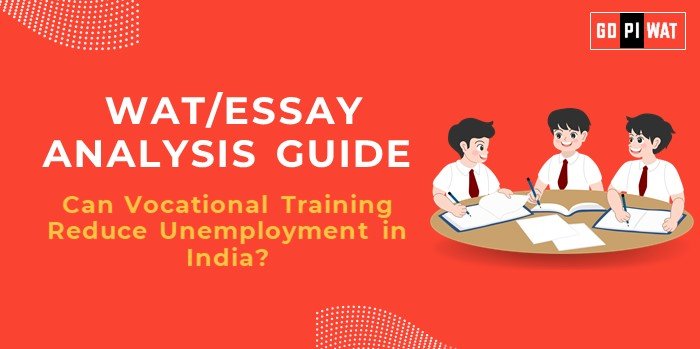📋 Can Vocational Training Reduce Unemployment in India?
🌐 Understanding Vocational Training’s Importance
Vocational training can be a transformative approach to reducing India’s high unemployment, especially among youth, by aligning skill development with industry demands. This makes it a compelling topic for B-school students exploring sustainable employment solutions.
🕒 Effective Planning and Writing
- ⏳ Time Allocation:
- Planning: 5 minutes
- Writing: 20 minutes
- Reviewing: 5 minutes
- 📖 Preparation Tips: Note recent data on unemployment, the skill gap, and the impact of major government initiatives like PMKVY to provide evidence for your argument.
✍️ Introduction Techniques for Essays
- 🔀 Contrast Introduction: “Despite India’s high unemployment, over 48% of employers report a skills shortage. Vocational training could address this gap, providing job-ready skills in high-demand sectors.”
- 💡 Solution-Oriented Introduction: “Vocational training presents a practical solution to India’s employment crisis by focusing on skill development in areas where demand outstrips supply.”
- 🕰️ Timeline Approach: “Since PMKVY’s launch in 2015, India has invested in skill development to bridge the gap between education and employment, with varying success.”
🏗️ Structuring the Essay Body
- 🏆 Achievements: Use data such as PMKVY’s impact on employment rates, rural outreach, and success in specific sectors like manufacturing.
- 📉 Challenges with Comparative Analysis: Discuss quality inconsistency and limited industry partnership, comparing with Germany’s highly standardized vocational model.
- 🔮 Future Outlook: Discuss areas for improvement, such as increased industry involvement, and integrating digital skills in vocational programs.
💡 Concluding Effectively
- ⚖️ Balanced Conclusion: “While vocational training has made progress, addressing quality and industry alignment will be essential for maximizing its potential in reducing unemployment.”
- 🔭 Future-Oriented Conclusion: “Vocational training could become India’s key to sustainable employment if quality and accessibility are prioritized in its expansion.”
📊 Analyzing Successes and Shortcomings
- 🎨 Key Achievements: Employment for millions, skill alignment in sectors like manufacturing.
- 💸 Ongoing Challenges: Quality inconsistency, limited reach in rural areas.
- 🌎 Global Context: Germany and Australia demonstrate successful models of vocational training integrated with formal education.
🚀 Recommendations for Sustainable Progress
- 📜 Increase Public-Private Partnerships: Collaborate with industries to ensure training is relevant and meets employer expectations.
- 💻 Standardize Curriculum Quality: Establish a nationwide accreditation system to maintain consistency across training centers.
- 📱 Expand Digital Skills Training: Integrate digital literacy into vocational training to prepare individuals for modern industry requirements.
✍️ Sample Short Essays
- ⚖️ Balanced Perspective: “Vocational training can bridge India’s skill gap and reduce unemployment, but without industry alignment, its potential remains limited.”
- 💡 Solution-Oriented: “By focusing on sector-specific skills, vocational training could be India’s answer to a growing employment crisis, especially for rural youth.”
- 🌍 Global Comparison: “India’s vocational training initiatives could mirror Germany’s success, offering practical skills that meet industry demand and reduce youth unemployment.”


